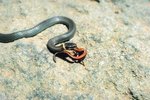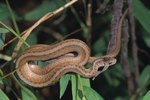Snakes aren't always massive, venomous creatures. Some of them are actually quite small and innocuous, such as the Brahminy blind snake (Ramphotyphlops braminus), which slightly resembles an earthworm. The terrestrial snake species is a common fixture in flowerpots and flower beds, and because of that is also often referred to by the moniker "flower pot snake."
Diet of the Brahminy Blind Snake
The Brahminy blind snake, a common sight in New Orleans, is such a wee animal that it doesn't have a particularly wide or diverse basic diet. Its small size restricts it from being able to consume larger prey. The Brahminy blind snake diet consists of ants, ant larvae, ant pupae, termite eggs and termites -- termites being an especially prominent source. The snakes also consume a variety of other tiny invertebrates and arthropods, such as springtails, millipedes and centipedes. Due to their small bodily size, the snakes tend to have preferences for bugs with comparatively soft bodies.
Harmless Animals
The mere word "snake" might strike abject fear in the heart of many people, although the Brahminy blind snake is totally harmless to human beings. The only organisms that should probably really fear the snakes are its prey: insects, insects and more insects. These very tiny snakes are nonvenomous, and as a result, cannot inject poison into people -- definitely a very good thing. The lack of venom isn't the only reason that the Brahminy blind snake is harmless to people. Though these blind snakes may do a lot of biting of small invertebrates, they are simply not capable of biting people. After all, their mouths are simply too tiny to do so, nothing more and nothing less.
Habitat
The Brahminy blind snake originated in southeastern Asia and was first identified in the United States in New Orleans, Louisiana, in 1993. The snakes thrive in temperate, warm and damp regions such as New Orleans and exists in other states, including Hawaii and Florida. The Brahminy blind snake appears in agricultural areas and also in large city settings. If loose and moist soil is abundant, then a Brahminy blind snake may just make a home there.
Carnivorous Snake Diets
All different species of snakes are carnivorous meat eaters, and Brahminy blind snakes are certainly no exception to this rule. The main difference lies in the types and sizes of meat that the snakes all eat. Since Brahminy blind snakes are small animals -- usually less than 7 inches long -- they aren't capable of going after bigger animals as prey. Many other snake species consume a wide array of meats that come from animals significantly bigger than bugs are. Think birds, amphibians, deer and rodents, just to name a few.
References
- Ohio Public Library Information Network: Brahminy Blind Snake
- Florida Fish and Wildlife Conservation Commission: Brahminy Blind Snake
- Florida Museum of Natural History: Brahminy Blind Snake
- ARKive: Brahminy Blind Snake
- State of Louisiana Department of Wildlife and Fisheries: Brahminy Blind Snake
- Loyola University New Orleans Center for Environmental Communication: Brahminy Blind Snake
- Reptile Channel: Blind Snakes
- California Herps: Brahminy Blind Snake




